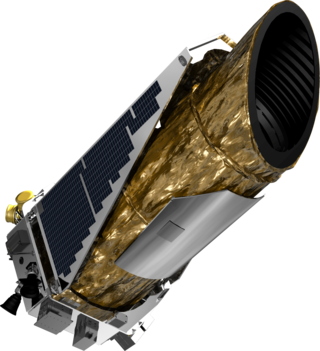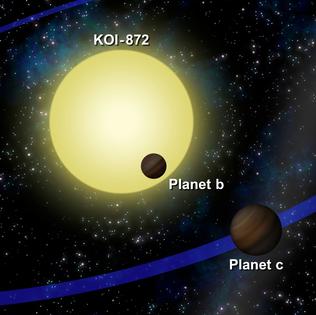Related Research Articles

A terrestrial planet, telluric planet, solid planet, or rocky planet, is a planet that is composed primarily of silicate rocks or metals. Within the Solar System, the terrestrial planets accepted by the IAU are the inner planets closest to the Sun: Mercury, Venus, Earth and Mars. Among astronomers who use the geophysical definition of a planet, two or three planetary-mass satellites – Earth's Moon, Io, and sometimes Europa – may also be considered terrestrial planets; and so may be the rocky protoplanet-asteroids Pallas and Vesta. The terms "terrestrial planet" and "telluric planet" are derived from Latin words for Earth, as these planets are, in terms of structure, Earth-like. Terrestrial planets are generally studied by geologists, astronomers, and geophysicists.

The Kepler space telescope is a disused space telescope launched by NASA in 2009 to discover Earth-sized planets orbiting other stars. Named after astronomer Johannes Kepler, the spacecraft was launched into an Earth-trailing heliocentric orbit. The principal investigator was William J. Borucki. After nine and a half years of operation, the telescope's reaction control system fuel was depleted, and NASA announced its retirement on October 30, 2018.

A super-Earth is an extrasolar planet with a mass higher than Earth's, but substantially below those of the Solar System's ice giants, Uranus and Neptune, which are 14.5 and 17 times Earth's, respectively. The term "super-Earth" refers only to the mass of the planet, and so does not imply anything about the surface conditions or habitability. The alternative term "gas dwarfs" may be more accurate for those at the higher end of the mass scale, although "mini-Neptunes" is a more common term.

Kepler-223 is a G5V star with an extrasolar planetary system discovered by the Kepler mission. Studies indicate that the Kepler-223 star system consists of 4 planets orbiting the star.
Kepler-14b is an extrasolar planet in orbit around the primary star of the binary Kepler-14 system. It is currently the only planet known to exist in this star system. Kepler-14b is 8.4 times the mass of Jupiter and has a radius 1.14 times that of Jupiter, and it orbits its host star every 6.79 days. It was discovered by NASA-led Kepler mission, which noted the planet as a planetary candidate as early as March 2009, around the same time as the discovery of the first five planets discovered by Kepler. However, the team was unable to confirm the planet until extensive follow-up observations, as high-resolution imaging resolved the star Kepler-14 as a closely orbiting binary system. The Kepler team would have not noticed that Kepler-14 was a binary star based solely on initial radial velocity measurements, and found that if they had not realized this, their data on Kepler-14b would have been very inaccurate.

Kepler-42, formerly known as KOI-961, is a red dwarf located in the constellation Cygnus and approximately 131 light years from the Sun. It has three known extrasolar planets, all of which are smaller than Earth in radius, and likely also in mass.

Kepler-46, previously designated KOI-872, is a star located in the constellation Lyra. Observed since 2009 by the Kepler space observatory, it has since been found to possess a planetary system consisting of at least three planets and while it has a similar mass to the Sun (90%) it is significantly older at ten billion years.
Kepler-47 is a binary star system in the constellation Cygnus located about 1055 parsecs away from Earth. The stars have three exoplanets, all of which orbit both stars at the same time, making this a circumbinary system. The first two planets announced are designated Kepler-47b, and Kepler-47c, and the third, later discovery is Kepler-47d. Kepler-47 is the first circumbinary multi-planet system discovered by the Kepler mission. The outermost of the planets is a gas giant orbiting within the habitable zone of the stars. Because most stars are binary, the discovery that multi-planet systems can form in such a system has impacted previous theories of planetary formation.
Kepler-80, also known as KOI-500, is a red dwarf star of the spectral type M0V. This stellar classification places Kepler-80 among the very common, cool, class M stars that are still within their main evolutionary stage, known as the main sequence. Kepler-80, like other red dwarf stars, is smaller than the Sun, and it has both radius, mass, temperatures, and luminosity lower than that of our own star. Kepler-80 is found approximately 1,218 light years from the Solar System, in the stellar constellation Cygnus, also known as the Swan.

Kepler-69c is a confirmed super-Earth extrasolar planet, likely rocky, orbiting the Sun-like star Kepler-69, the outermore of two such planets discovered by NASA's Kepler spacecraft. It is located about 2,430 light-years from Earth.
Kepler-32 is an M-type main sequence star located about 1070 light years from Earth, in the constellation of Cygnus. Discovered in January 2012 by the Kepler spacecraft, it shows a 0.58 ± 0.05 solar mass (M☉), a 0.53 ± 0.04 solar radius (R☉), and temperature of 3900.0 K, making it half the mass and radius of the Sun, two-thirds its temperature and 5% its luminosity.
Kepler-32c is an extrasolar planet in orbit around its M-dwarf-type star in the Kepler-32 system, in the constellation of Cygnus. Discovered by planetary transit methods with the Kepler space telescope in January 2012, it presents a semi-major axis of 0.033 AU and temperature of 417.3 K. It has a radius of 2.2 Earth-radius and an orbital period of 8.7522 days.

Kepler-69 is a G-type main-sequence star similar to the Sun in the constellation Cygnus, located about 2,430 ly (750 pc) from Earth. On April 18, 2013 it was announced that the star has two planets. Although initial estimates indicated that the terrestrial planet Kepler-69c might be within the star's habitable zone, further analysis showed that the planet very likely is interior to the habitable zone and is far more analogous to Venus than to Earth and thus completely inhospitable.
Kepler-70c is one of two postulated exoplanets orbiting the sdB star Kepler-70. Their discovery was announced in 2011. However, later research suggests that the two exoplanets probably do not exist, and that "pulsation modes visible beyond the cut-off frequency of the star" were a more likely explanation for the signals believed to indicate exoplanets. This is not proven with certainty one way or the other.

Kepler-56 is a red giant in constellation Cygnus roughly 3,060 light-years (940 pc) away with slightly more mass than the Sun.

Kepler-138, also known as KOI-314, is a red dwarf located in the constellation Lyra, 219 light years from Earth. It is located within the field of vision of the Kepler spacecraft, the satellite that NASA's Kepler Mission used to detect planets transiting their stars.
Kepler-444 is a triple star system, estimated to be 11.2 billion years old, approximately 119 light-years (36 pc) away from Earth in the constellation Lyra. On 27 January 2015, the Kepler spacecraft is reported to have confirmed the detection of five sub-Earth-sized rocky exoplanets orbiting the main star. The star is a K-type main sequence star. All of the planets are far too close to their star to harbour life forms.
Kepler-419 is an F-type main-sequence star located about 3,400 light years from Earth in the constellation Cygnus. It is located within the field of vision of the Kepler spacecraft, the satellite that NASA's Kepler Mission used to detect planets that may be transiting their stars. In 2012, a potential planetary companion in a very eccentric orbit was detected around this star, but its planetary nature was not confirmed until 12 June 2014, when it was named Kepler-419b. A second planet was announced orbiting further out from the star in the same paper, named Kepler-419c.
Kepler-13 or KOI-13 is a stellar triple star system consisting of Kepler-13A, around which an orbiting hot Jupiter exoplanet was discovered with the Kepler spacecraft in 2011, and Kepler-13B a common proper motion companion star which has an additional star orbiting it.
KOI-5 is a triple star system composed of three stars: KOI-5 A, KOI-5 B and KOI-5 C, orbiting 1,870±70 light-years away.
References
- 1 2 Swift, Jonathan J. (2012). "Characterizing the Cool KOIs IV: Kepler-32 as a prototype for the formation of compact planetary systems throughout the Galaxy". The Astrophysical Journal. 764 (1): 105. arXiv: 1301.0023 . Bibcode:2013ApJ...764..105S. doi:10.1088/0004-637X/764/1/105. S2CID 43750666.
- ↑ Fabrycky, Dan (2 Feb 2012). "Kepler-32b". NASA. Archived from the original on 3 May 2012. Retrieved 2 Mar 2013.


